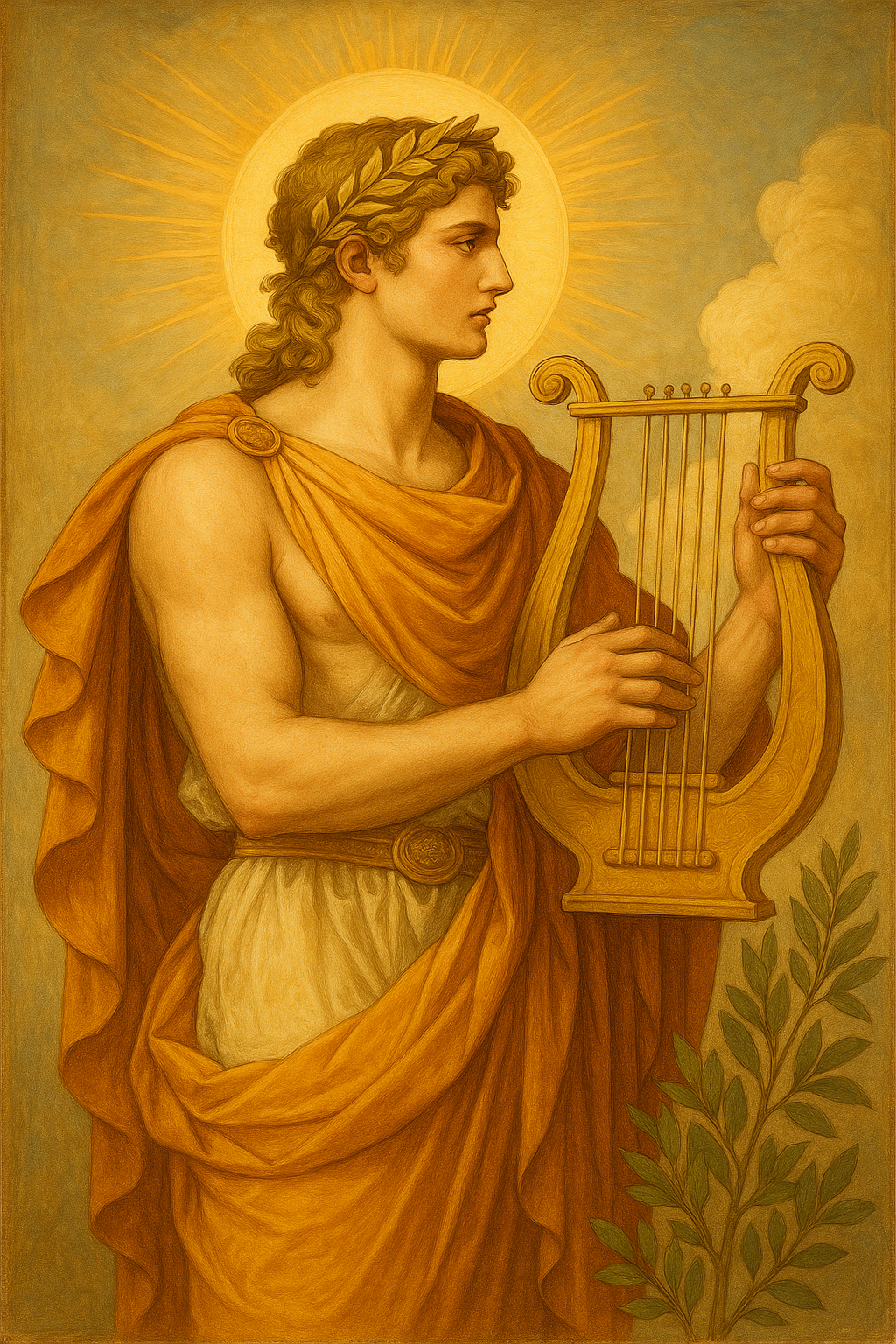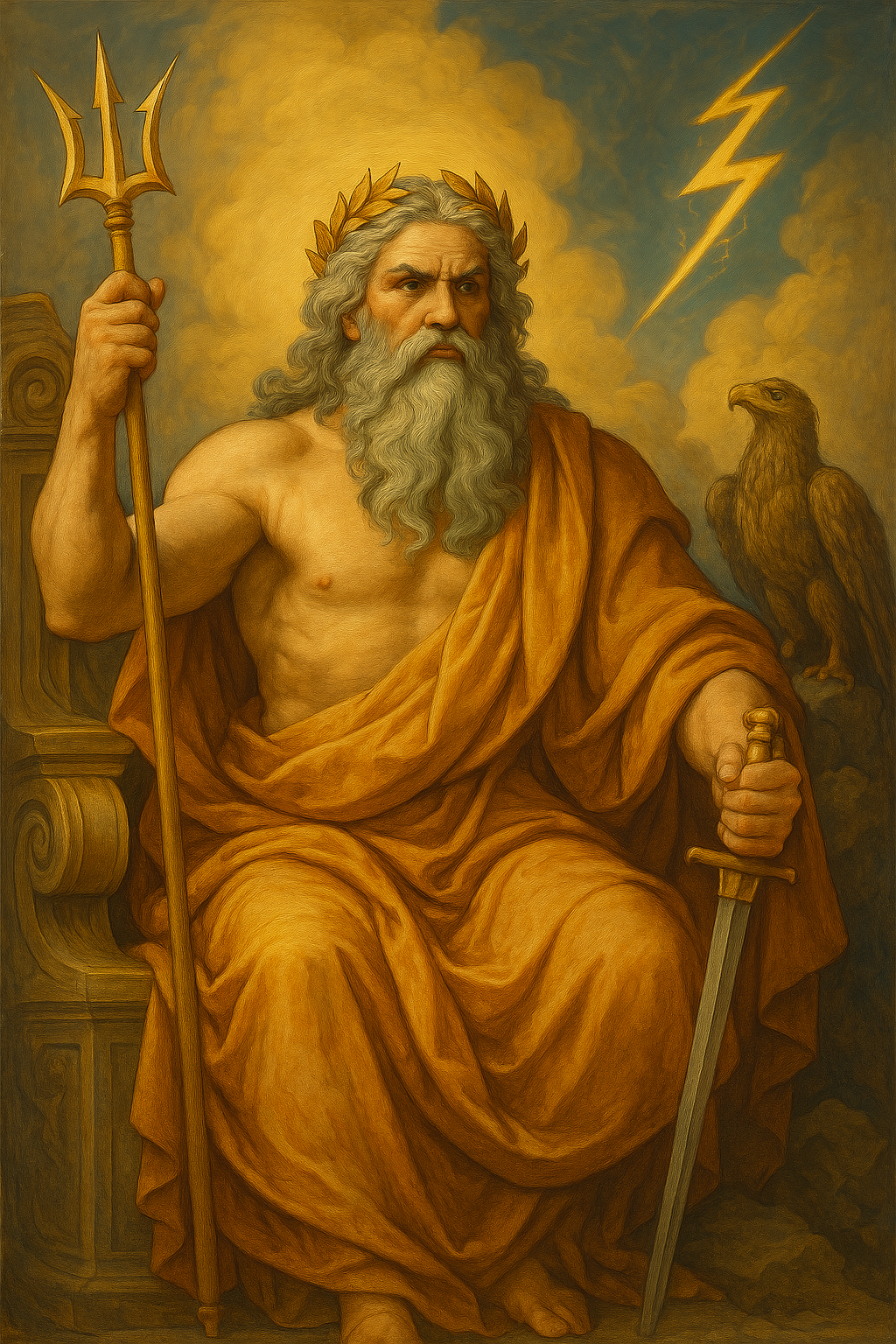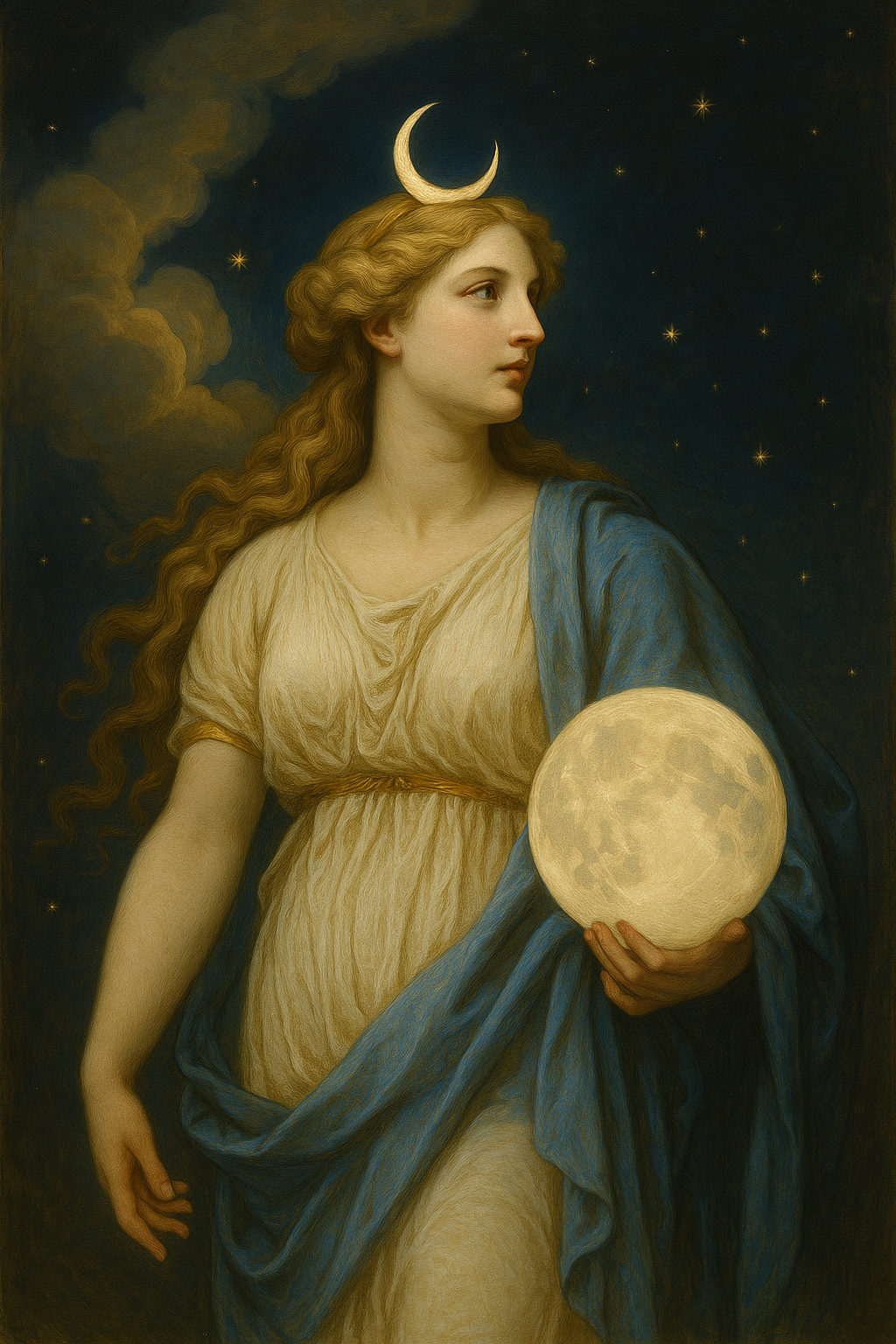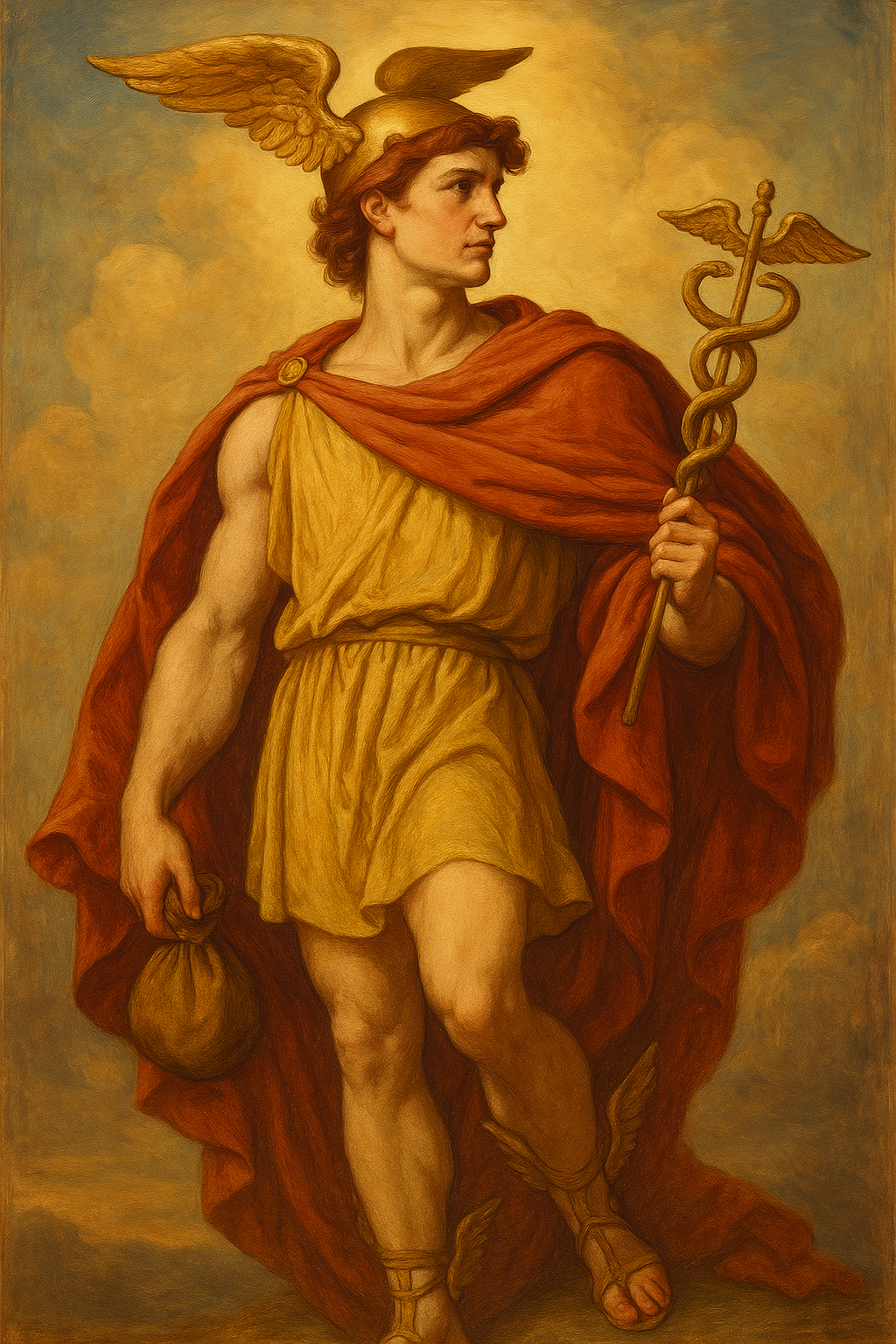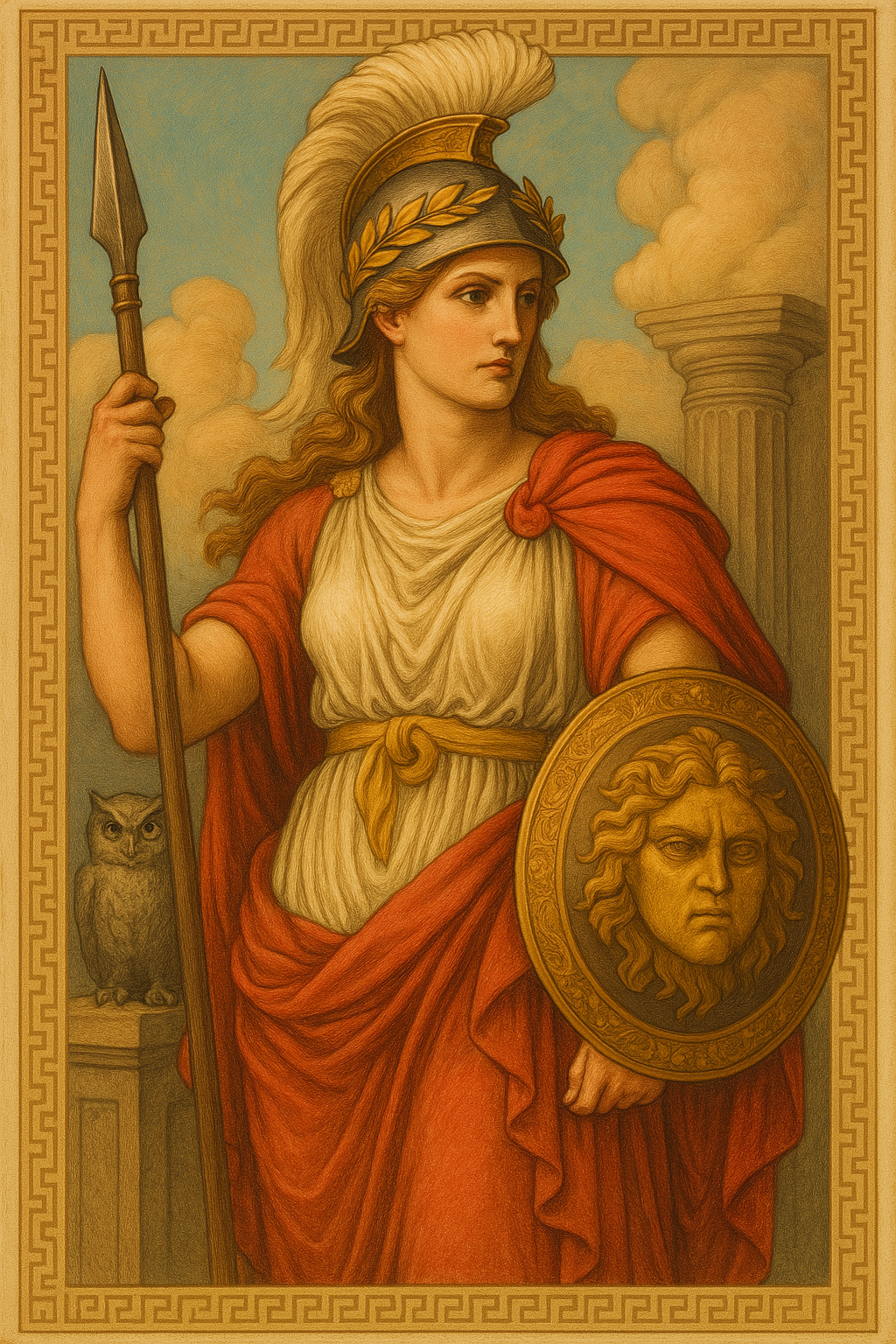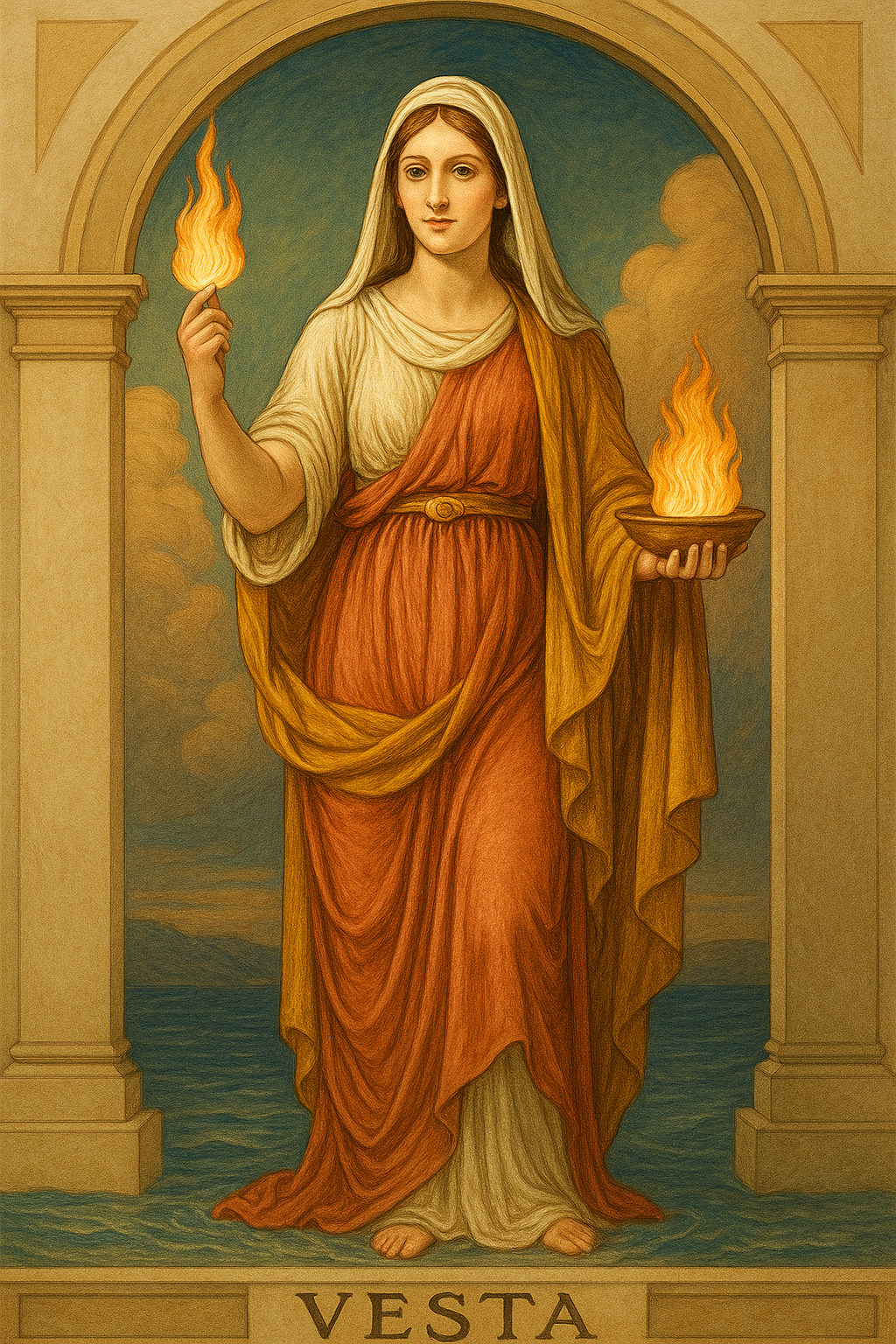A Brief Overview of Roman Mythology
Roman mythology is the body of traditional stories, beliefs, and rituals of ancient Rome, deeply influenced by Greek mythology, yet shaped by Rome’s unique values, culture, and political identity. While many Roman gods share names and attributes with their Greek counterparts, Roman mythology places a stronger emphasis on duty, order, and the state.
The major gods include Jupiter (king of the gods), Juno (marriage), Mars (war), Venus (love), and Minerva (wisdom).
Household and agricultural deities like Vesta (hearth), Janus (beginnings), and Ceres (grain) played vital roles in daily life.
Mythology was intertwined with civic religion—rituals, priesthoods, and festivals like Saturnalia honored the gods and reinforced Roman values.
Founding myths, like the tale of Romulus and Remus, emphasized Rome’s divine origins, destiny, and imperial mission.
While often adopting Greek stories, Romans reinterpreted them to highlight Roman virtues like discipline, loyalty, courage, and leadership.
Roman mythology served not only as religious belief but also as a tool of cultural identity, political power, and moral guidance for one of history’s greatest empires.
Roman Goddesses & Gods
A-Z
-
Apollo, one of the most revered gods in Roman mythology (adopted directly from the Greeks with the same name), is the god of the sun, prophecy, music, healing, and the arts. He is depicted as a youthful, radiant figure carrying a lyre and often associated with truth, harmony, and intellectual pursuits. As the son of Jupiter and Latona (Leto), and twin brother of Diana (Artemis), Apollo embodies both light and knowledge. He was the patron of the Oracle at Delphi and was believed to guide and inspire through divine insight. In Roman culture, Apollo also came to symbolize order, discipline, and the ideal of civilized life.
-
Aurora is the Roman goddess of the dawn, equivalent to the Greek goddess Eos. Each morning, she rises from the horizon to open the gates of the sun and announce the arrival of a new day, often described as flying across the sky in a chariot with rosy fingers or golden light. Aurora is associated with renewal, hope, and the daily rebirth of the world. In myth, she is known for her many mortal lovers, a result of a curse from Venus that made her fall endlessly in love. Aurora symbolizes the beauty and fleeting nature of beginnings, as well as the transition from darkness to light.
-
Bacchus is the Roman god of wine, revelry, ecstasy, and fertility, equivalent to the Greek god Dionysus. He embodies the liberating and chaotic aspects of nature, celebration, and human emotion. Often depicted with grapevines, a drinking cup, and accompanied by satyrs and maenads, Bacchus represents both the joy of life and the potential for excess. His worship included wild festivals known as Bacchanalia, which were initially secretive and ecstatic rites. Bacchus symbolizes not just indulgence, but also transformation, inspiration, and the breaking of boundaries between the mortal and divine.
-
Caelus is the Roman personification of the sky, equivalent to the Greek primordial god Uranus. As a primal deity, he represents the heavens and the vast, overarching dome of the sky. Caelus is often considered one of the earliest gods, embodying the celestial realm that existed before the rise of the more familiar Olympian deities. In myth, he is the consort of Terra (the Earth) and the father of several other powerful beings, including the Titans. Though not prominent in Roman worship or stories, Caelus symbolizes the vast, eternal heavens and the cosmic origins of the universe.
-
Ceres is the Roman goddess of agriculture, grain, fertility, and motherly love, equivalent to the Greek goddess Demeter. She was deeply revered as the protector of the harvest and the cycle of life and death through the growth of crops. Ceres is best known for her connection to her daughter, Proserpina (Persephone), whose abduction by Pluto (Hades) led to the seasonal cycle—Ceres' grief caused the earth to become barren until Proserpina’s return each spring. Worship of Ceres was central to Roman life, especially among farmers, and her rites, such as the Cerealia, honored the essential bond between humans and the fertile earth.
-
Cupid is the Roman god of love, desire, and affection, equivalent to the Greek god Eros. He is often depicted as a winged child or youthful figure armed with a bow and arrows—those struck by his golden arrows fall deeply in love, while leaden ones cause aversion. The son of Venus (goddess of love), Cupid plays a mischievous yet powerful role in both divine and mortal affairs. His most famous myth is the love story of Cupid and Psyche, which explores themes of trust, transformation, and the enduring power of love. Cupid symbolizes not only romantic attraction but also the unpredictable and transformative nature of love itself.
-
Cybele is a powerful and ancient mother goddess worshipped in Roman religion, originally adopted from Phrygian (Anatolian) mythology. Known as Magna Mater (“Great Mother”), she represents fertility, nature, wild animals, mountains, and protection. Cybele is often depicted wearing a crown shaped like a city wall and riding in a chariot pulled by lions, symbolizing her dominion over nature and civilization alike.
Her worship in Rome was passionate and intense, involving ecstatic rituals, drumming, and dancing led by her priesthood, the Galli, who practiced self-denial and devotion. Cybele was associated with death and rebirth through the myth of her consort Attis, whose tragic fate reflected the seasonal cycle. She embodies the fierce, untamed aspects of motherhood, the life-giving earth, and the primal forces of creation and transformation.
-
Diana is the Roman goddess of the hunt, the moon, wild animals, and childbirth, equivalent to the Greek goddess Artemis. She is often depicted as a youthful, athletic figure with a bow and quiver, accompanied by a deer or hunting dogs. A virgin goddess, Diana is fiercely independent and protective of women, especially during childbirth, as well as of nature and the wilderness.
She is also associated with the moon, particularly in later Roman worship, and came to be linked with lunar cycles and feminine power. As a triple goddess figure, Diana was sometimes worshipped in her aspects as maiden (huntress), mother (nurturer), and crone (protector of the underworld). She represents strength, purity, freedom, and the sacred balance between civilization and nature.
-
Faunus is the Roman god of the forest, fields, flocks, and fertility, often associated with nature, rustic music, and prophetic insight. He is a pastoral deity, similar to the Greek god Pan, and is usually depicted with goat-like features—horns, hooves, and a playful spirit. Faunus is known for his connection to wildlife and the untamed countryside, embodying the joyful, chaotic energy of nature.
He was also believed to speak through dreams and oracles, offering guidance to those who listened. Faunus was honored during festivals like the Lupercalia, which celebrated fertility and purification. As both a protector of shepherds and a wild, mischievous spirit, Faunus symbolizes the life force of nature, fertility, instinct, and freedom.
-
Flora is the Roman goddess of flowers, spring, and blossoming plants. She embodies the renewal of life, the beauty of nature, and the fertility of the earth. Though a relatively gentle and peaceful deity, Flora held an important place in Roman culture as a symbol of growth, vitality, and the natural cycle of seasons.
Her festival, the Floralia, was celebrated in late April and early May with flowers, games, and theatrical performances to welcome the return of spring and encourage the blooming of crops and gardens. Often depicted crowned in blossoms or scattering petals, Flora represents joy, fertility, and the fleeting but beautiful nature of life in bloom.
-
Fortuna is the Roman goddess of luck, fate, and fortune—both good and bad. She personifies the unpredictable nature of life and the shifting balance of success and misfortune. Often depicted with a wheel (the Wheel of Fortune), a blindfold, or a cornucopia, she symbolizes the randomness of fate and the abundance or loss it can bring.
Fortuna was widely worshipped across Rome by people from all walks of life, from emperors to commoners, each hoping to gain her favor. She had many aspects, such as Fortuna Primigenia (firstborn, linked to destiny at birth) and Fortuna Redux (bringing safe return from journeys). As a capricious and powerful force, Fortuna reminds us that life’s outcomes are often beyond our control—subject to sudden change, for better or worse.
-
Janus is the Roman god of beginnings, endings, transitions, and doorways. Unique to Roman mythology with no direct Greek equivalent, he is most famously depicted with two faces—one looking to the past and the other to the future. Janus governs all forms of passage: physical (gates, roads, thresholds) and symbolic (time, change, choices).
As the guardian of transitions, he was invoked at the start of important events, including battles, contracts, and even each new day. The month of January is named after him, marking the start of the year. Janus represents duality, reflection, and the continuous flow of time, making him a powerful symbol of fresh starts and turning points.
-
Juno is the Roman queen of the gods and the goddess of marriage, women, childbirth, and the protection of the state. She is the wife and sister of Jupiter (the Roman equivalent of Zeus) and is closely aligned with the Greek goddess Hera. Regal and powerful, Juno is often depicted wearing a crown and holding a scepter or accompanied by a peacock, her sacred animal.
Juno was deeply honored as the protector of Roman women and matronly virtue. She had several aspects, including Juno Regina (Queen), Juno Moneta (Warner or Advisor), and Juno Lucina (Bringer of Light, associated with childbirth). As a guardian of personal and civic life, Juno symbolizes strength, dignity, loyalty, and the sacred bonds of marriage and community.
-
Jupiter is the king of the Roman gods and the god of the sky, thunder, and law. He is the Roman counterpart of the Greek god Zeus and was the most powerful deity in the Roman pantheon. Often depicted holding a lightning bolt and seated on a throne, Jupiter ruled over both the heavens and the affairs of mortals with authority and wisdom.
As the chief guardian of Rome and the enforcer of justice and oaths, Jupiter was central to Roman state religion. His temple on the Capitoline Hill—the Temple of Jupiter Optimus Maximus—was one of the most important in Rome. He was also associated with the eagle, a symbol of divine power. Jupiter embodies sovereignty, order, and the might of divine rule, guiding both the cosmos and the empire.
-
Luna is the Roman goddess of the moon, equivalent to the Greek goddess Selene. She personifies the moon itself and is often depicted as a radiant woman driving a silver chariot across the night sky, drawn by horses or oxen. Luna governs the rhythms of time, especially the lunar cycle, and is associated with intuition, dreams, and the feminine divine.
Though not as prominent as some other Roman deities, she was honored in various rituals and often invoked alongside the sun god Sol and the dawn goddess Aurora, representing the celestial balance of day and night. Luna symbolizes mystery, reflection, and the quiet, cyclical power of the moon’s light over nature and the human spirit.
-
Mars is the Roman god of war, military power, and masculinity, and one of the most important deities in Roman religion. Unlike his Greek counterpart Ares—who was seen as chaotic and destructive—Mars was honored as a noble and disciplined warrior, a protector of Rome and its people. He was also associated with agriculture in early Roman tradition, reflecting his role in defending both the land and its fertility.
Mars was considered the father of Romulus and Remus, the legendary founders of Rome, strengthening his connection to Roman identity and destiny. He was often depicted as a strong, armored figure bearing a spear or sword. Mars symbolizes courage, strength, and the disciplined might necessary to build and protect a civilization.
-
Mercury is the Roman god of commerce, communication, travelers, and thievery, closely associated with speed, wit, and adaptability. He is the Roman counterpart of the Greek god Hermes and is often depicted wearing winged sandals and a winged helmet, carrying a caduceus—a staff entwined with two serpents.
As the messenger of the gods, Mercury moves freely between the mortal and divine realms, guiding souls to the underworld and delivering messages from Jupiter. He is also the patron of merchants, messengers, and tricksters, embodying cleverness and eloquence. Mercury symbolizes movement, exchange, intelligence, and the ever-shifting flow of information and ideas.
-
Minerva is the Roman goddess of wisdom, strategic warfare, crafts, and the arts, equivalent to the Greek goddess Athena. She is often depicted wearing a helmet and armor, sometimes with an owl—symbolizing insight and intellect—by her side. Unlike Mars, who represents brute force, Minerva embodies the disciplined, strategic side of war and the power of reason over violence.
She was one of the Capitoline Triad alongside Jupiter and Juno, and was deeply respected as a guardian of learning, justice, and civilization. Minerva was also the patron of artisans, inventors, and teachers. As a virgin goddess, she symbolizes clarity of thought, creativity, and the strength found in intelligence and skill.
-
Neptune is the Roman god of the sea, freshwater, earthquakes, and horses, equivalent to the Greek god Poseidon. He is often depicted as a powerful, bearded figure wielding a trident and riding a chariot drawn by sea creatures or horses. Originally a god of freshwater, Neptune later took on dominion over the oceans, reflecting Rome’s growing naval influence.
Though less temperamental than Poseidon in myth, Neptune was still seen as a mighty and unpredictable force of nature. He was honored in festivals such as the Neptunalia, which celebrated water during the heat of summer. Neptune symbolizes the strength and depth of the sea, the untamed forces of the natural world, and the Roman respect for power, motion, and mystery.
-
Pluto is the Roman god of the underworld, wealth, and the dead, equivalent to the Greek god Hades. He rules over the realm of the dead with fairness and finality, not as a figure of evil, but as a necessary force in the balance of life and death. His name is derived from Plouton, meaning "the rich one," reflecting the wealth of minerals and precious metals found underground.
Pluto is often depicted as a stern, regal figure holding a scepter or a key, symbolizing his dominion over the hidden world. He is also associated with his queen, Proserpina (Persephone), whose seasonal return to the earth explains the cycle of the seasons. Pluto embodies mystery, transformation, and the inevitable journey every soul must take, ruling with solemn authority over the silent depths of the afterlife.
-
Proserpina is the Roman goddess of spring and the queen of the underworld, equivalent to the Greek goddess Persephone. She is the daughter of Ceres (goddess of agriculture) and was abducted by Pluto (god of the underworld) to become his wife. Her mother’s grief caused the earth to grow barren, but a compromise allowed Proserpina to spend part of the year above ground and part in the underworld.
This myth explains the changing seasons—her return brings spring and fertility, while her descent marks autumn and winter. Proserpina symbolizes rebirth, transformation, and the cycle of life and death. She embodies both youthful vitality and the mysterious depth of the underworld, bridging two powerful realms of Roman belief.
-
Saturn is the Roman god of time, harvest, wealth, and agriculture, equivalent to the Greek Titan Cronus. He is often depicted with a sickle or scythe, symbolizing his role in the sowing and reaping of crops. As a former ruler of the gods before Jupiter overthrew him, Saturn represents an older, golden age of peace, abundance, and simplicity.
One of the most important festivals in his honor was Saturnalia, a joyous, week-long celebration in December marked by feasting, gift-giving, and role reversals—symbolizing a temporary return to the harmony and equality of his reign. Saturn embodies the passage of time, the rewards of labor, and the enduring rhythms of nature and civilization.
-
Sol is the Roman god and personification of the sun, equivalent to the Greek god Helios. He is often depicted as a radiant, golden figure driving a chariot across the sky, pulled by fiery horses, bringing daylight to the world. Although initially a minor deity in early Roman religion, Sol Invictus ("the Unconquered Sun") rose to prominence during the later Roman Empire, especially under emperors like Aurelian, who promoted him as a supreme cosmic power.
Sol symbolizes light, vitality, order, and the eternal cycle of day and night. His rising and setting marked the passage of time and the promise of renewal, making him a powerful symbol of life, stability, and divine presence shining over all creation.
-
Somnus is the Roman god of sleep, equivalent to the Greek god Hypnos. He is a gentle and shadowy figure who brings rest and dreams to mortals and gods alike. Often depicted as a winged youth or reclining in a peaceful slumber, Somnus resides in a dark, quiet cave near the river Lethe, surrounded by poppies and other sleep-inducing plants.
He is the brother of Mors (Death) and the father of the dream gods, the Somnia or Oneiroi, including Morpheus, who shapes dreams. Somnus symbolizes rest, healing, and the boundary between consciousness and the subconscious. As a soothing and necessary force, he reminds us of the power of dreams, the mystery of the night, and the peace that comes with surrendering to sleep.
-
Terra, also known as Tellus, is the Roman goddess and personification of the Earth, equivalent to the Greek goddess Gaia. She is one of the oldest and most fundamental deities in Roman mythology, representing fertility, stability, and the life-giving power of nature. Terra is the mother of all living things—plants, animals, and humans—and is often depicted as a nurturing, matronly figure surrounded by crops, fruits, or animals.
She was honored in various agricultural festivals, such as Fordicidia, where offerings were made to ensure the fertility of the land. Terra symbolizes abundance, motherhood, and the grounding force of the natural world, embodying the earth as both a physical foundation and a divine presence essential to life itself.
-
Venus is the Roman goddess of love, beauty, desire, and fertility, equivalent to the Greek goddess Aphrodite. She embodies the irresistible force of attraction that binds all living things together—gods and mortals alike. Often depicted as a radiant, graceful figure rising from the sea or accompanied by doves and roses, Venus symbolizes romance, sensuality, and the generative power of nature.
She held a special place in Roman culture not only as a goddess of love but also as a divine ancestor of the Roman people through her son Aeneas, the Trojan hero and legendary founder of Rome. Venus was widely worshipped in both public temples and private homes, and her influence extended into art, politics, and family lineage. She represents beauty, charm, the spark of passion, and the creative force that brings life and harmony into the world.
-
Vesta is the Roman goddess of the hearth, home, and sacred fire, equivalent to the Greek goddess Hestia. She embodies the warmth and stability of the household and the unifying spirit of family and community. Vesta's flame was considered vital to both domestic life and the wellbeing of the Roman state, burning eternally in her temple in the Roman Forum.
Her priestesses, the Vestal Virgins, were entrusted with maintaining this sacred fire and took vows of chastity to preserve their spiritual purity. Vesta was unique among the gods in that she had no elaborate mythology; instead, she was deeply revered for her quiet, constant presence. She symbolizes purity, protection, continuity, and the central role of home in Roman life and society.
-
Vulcan is the Roman god of fire, volcanoes, blacksmithing, and craftsmanship, equivalent to the Greek god Hephaestus. He is the divine smith of the gods, forging weapons, armor, and tools in his blazing workshop beneath the earth. Often depicted with a hammer and anvil, Vulcan represents the transformative power of fire—both destructive and creative.
Despite his physical imperfections and being cast out from the heavens by Jupiter or Juno (depending on the myth), Vulcan is a master artisan whose skill is unmatched. He was married to Venus, though their union was marked by infidelity and tension. Vulcan symbolizes ingenuity, resilience, and the raw elemental forces that build and shape the world. His festival, Vulcanalia, was held in August to appease the god and protect against destructive fires.
